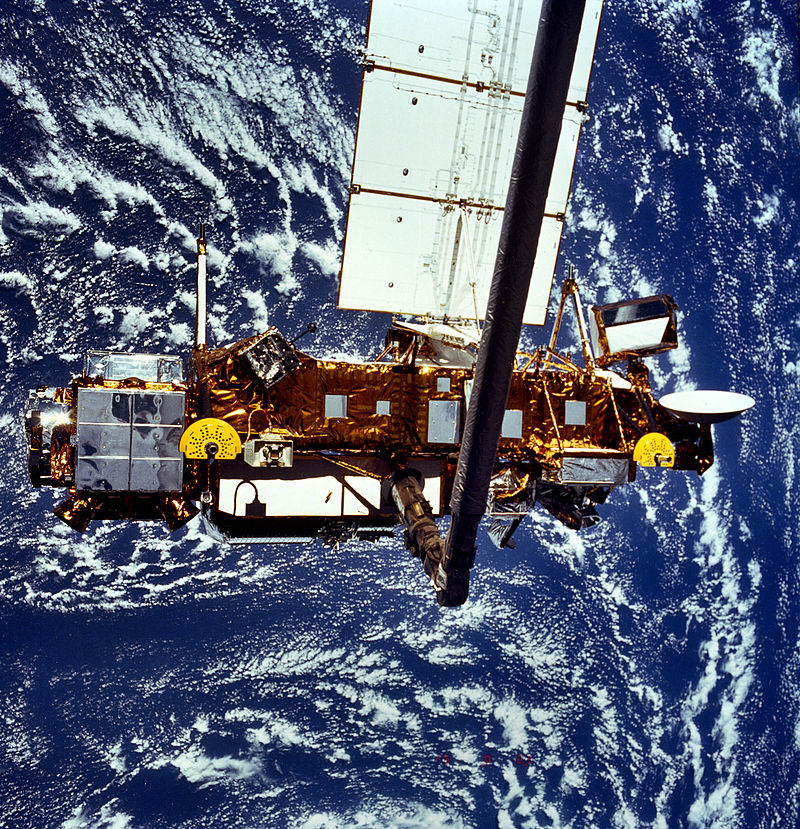
Late in September 2011, the skies above the Pacific Ocean were illuminated by an astonishing, though not unexpected, fire show. NASA’s 13,000-pound (5,900-kg) Upper Atmosphere Research Satellite (UARS)—launched 25 years ago, this week, in September 1991—returned to Earth in a blaze of glowing debris, with the remnants splashing down in a remote stretch of the Pacific.
Originally anticipated to operate for just two years, the UARS mission was extended several times, and even when budget cuts forced it to be decommissioned in June 2005 no less than six of its nine instruments were still fully functional. Its orbit was slightly lowered by flight controllers in December 2005, in anticipation of an eventual destructive re-entry, and in October 2010 the crew of the International Space Station (ISS) was obliged to perform a debris avoidance maneuver in response to a conjunction with the aging satellite. Its eventual descent to Earth on 24 September 2011 brought a rather high-profile closure to a mission which had proven instrumental in changing our perception of the Home Planet.
Built by General Dynamics, under an initial $145 million contract with NASA which soon expanded into a billion-dollar program, UARS could trace its heritage to well before the loss of Challenger. It was originally scheduled to be launched by the shuttle in October 1989 as a long-duration observatory to monitor gas concentrations and pressures, the effects of solar irradiance, and ozone concentrations in Earth’s fragile atmosphere. From its 373-mile (600-km) vantage point, inclined 57 degrees to the equator, the satellite would have the capability to observe up to 80 degrees in latitude, thus affording it essentially global coverage of Earth’s stratosphere and mesosphere.
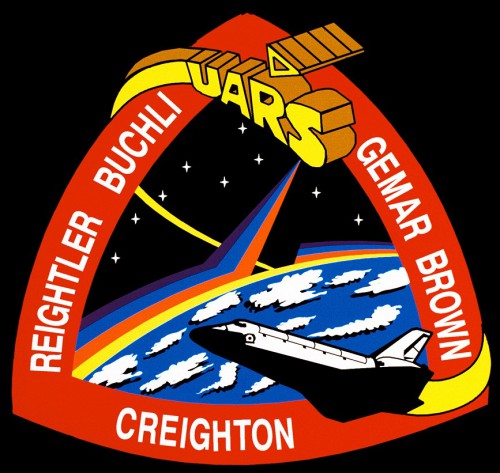
This would enable UARS to make measurements over the full range of local time zones in all major geographical locations, every 36 days. The instruments aboard the satellite were expected to produce the most complete data on solar energy inputs, terrestrial winds, and atmospheric composition ever gathered. These explored the composition and distribution of nitrogen and chlorine compounds, together with ozone, water vapor, and methane, measured thermal emissions to create vertical abundance profiles of atmosphere gases, determined temperatures and pressure characteristics of high-altitude winds, and analyzed the effect of solar ultraviolet radiation.
Significantly, UARS’s 10 instruments were designed to operate as a single experiment, capable of providing atmospheric scientists with an opportunity to make simultaneous measurements of all factors affecting ozone depletion. Four of those instruments measured the concentrations and distributions of gases known to play an integral role in the depletion process. The Cryogenic Limb Array Etalon Spectrometer examined concentrations of nitrogen and chlorine, ozone, water vapor, and methane, whilst the Improved Stratospheric and Mesospheric Sounder also monitored carbon dioxide, nitrous oxide, nitric acid, and carbon monoxide. Meanwhile, the Microwave Limb Sounder provided the first “global” data set on chlorine monoxide (the key intermediate compound in the ozone-destruction cycle), and the Halogen Occultation Experiment observed vertical distributions of hydrofluoric acid and members of the nitrogen family.
Two other instruments—the High-Resolution Doppler Imager and the Wind Imaging Interferometer—provided the first direct measurements, on a global scale, of horizontal winds responsible for dispersing chemicals and aerosols in the upper atmosphere. Elsewhere, the Solar Ultraviolet Spectral Irradiance Monitor, the Solar Stellar Irradiance Comparison Experiment, and the Particle Environment Monitor studied the effect of incoming solar energy on the atmosphere. Additionally, the Active Cavity Radiometer Irradiance Monitor offered accurate determination of total solar activity over the long term to aid climatic studies.
When the STS-48 crew was announced in December 1990, they confidently anticipated launch in November of the following year, but shuttle delays in the spring of 1991 actually conspired to bring their flight forward. Original plans for Discovery saw her flying the STS-39 mission for the Department of Defense in March, followed by the deployment of the fifth Tracking and Data Relay Satellite (TDRS-E) on STS-43 in July and finally UARS in November. When Discovery found herself grounded for more than six weeks, due to cracks on the lug hinges of her External Tank (ET) umbilical door drive mechanism, STS-43 was pushed onto sister ship, Atlantis, and the UARS mission was brought forward to October and, finally, September. With a scheduled operational lifetime of 20 months, a fall launch was highly desirable in that it would enable UARS researchers to observe at least two winters in the northern hemisphere and at least one season examining the much-publicized “hole” in the ozone layer above Antarctica. For STS-48 commander John Creighton—nicknamed “J.O.”—it made a pleasant change to fly somewhat earlier than planned.
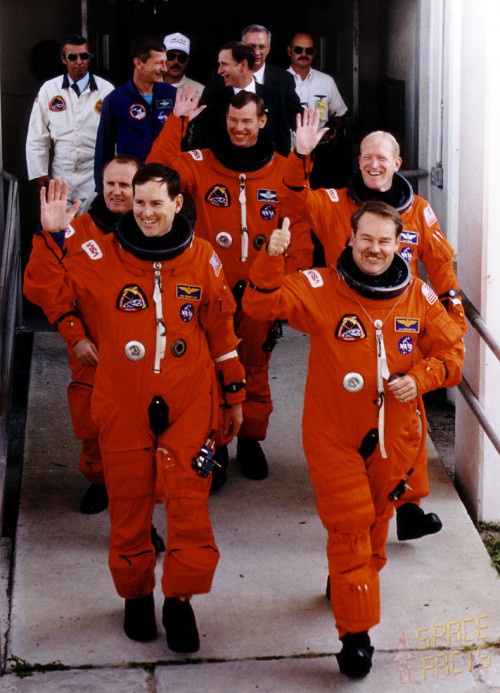
With launch almost a year away, Creighton and his crewmates—his pilot, Ken Reightler, and mission specialists Charles “Sam” Gemar, Jim Buchli, and Mark Brown—were given low priority in the simulators for the first few weeks. That changed with Discovery’s delays. “All of a sudden,” Creighton recalled, “we found out we were going to leapfrog a couple of other flights and be sooner, rather than later, so then we really had to scramble. That was a tough nine or ten months of very intense training.”
In addition to its high orbital inclination of 57 degrees to the equator, UARS also demanded one of the highest altitudes ever reached by the shuttle: some 373 miles (600 km), slightly less than the Hubble Space Telescope (HST). However, unlike Hubble, which had been delivered into a 28.45-degree-inclination orbit by the STS-31 crew in April 1990, the STS-48 astronauts rose to a higher inclination of 57 degrees. “We set a world altitude record for a winged vehicle” at 57 degrees inclination, Creighton proudly said of STS-48 and to this day he retains the commemorative plaque to prove it. His launch was finally set for 12 September 1991, and after a brief, 14-minute delay, caused by noisy interference on the air-to-ground communications link, Discovery roared into space at 7:11 p.m. EDT. The early evening launch time, and the requirement for them to rise from their beds in the early afternoon, prompted Creighton to describe STS-48 as “gentleman’s hours.”
Most of the STS-48 crew had flown before. Jim Buchli, in fact, was only the second person (after Bob Crippen) to fly as many as four times on the shuttle and had served a stint as deputy chief of the astronaut office, but for Ken Reightler it was his first mission and it surpassed all of his expectations. Years later, he told a Smithsonian interviewer, with more than a hint of humor, that the task of the pilot was “to start the Auxiliary Power Units, to lower the landing gear and to make the mission commander look good.”
That said, Reightler’s role in an emergency situation would be quite different: to instinctively respond to any contingency, to hold a great deal of knowledge about the shuttle’s systems and hundreds of switches and controls, and to potentially exercise that knowledge, in a timely manner, to save his own life and those of his crewmates. Jim Buchli had likened a shuttle launch to being strapped onto the front of a freight train at full speed. Not surprisingly, on STS-48, Reightler was anxious to perform at his peak. One concern was his bulky orange partial-pressure suit, which he felt was “pulling” on his body and might make it difficult for him to reach switches. “To bolster my confidence, right after liftoff, I started systematically reaching around the cockpit as the G-forces started to build,” he related.
At length, glancing periodically over at his rookie pilot, Creighton politely asked “Would you knock that off?” Reightler did just that, “and the rest of the ride to orbit was a dream come true.”
The second part of this article will appear tomorrow.
Want to keep up-to-date with all things space? Be sure to “Like” AmericaSpace on Facebook and follow us on Twitter: @AmericaSpace




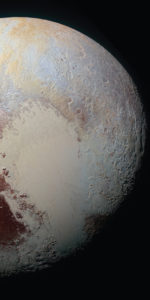
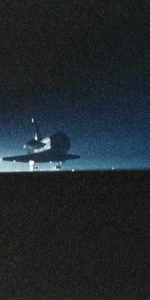
UARS was designed, developed, built, tested, and operated by General Electric Space division Valley Forge, PA
(merged with RCA Astro) for NASA GSFC.
NOT General Dynamics